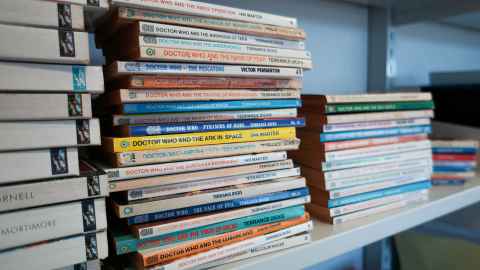My Space: Professor Jan Eldridge
1 August 2024
In the first of a regular series exploring some of the special spaces around the University of Auckland, Professor Jan Eldridge (head of physics) talks to UniNews about her unique office.

Professor Jan Eldridge grew up in the UK reading classic sci-fi, watching Doctor Who and zooming around in Star Wars spacecraft in computer games.
A career spent among the stars, it seems, was destined.
“It all comes together in this perfect storm to explain why I do the science I do,” explains the University’s head of physics – a theoretical astrophysicist whose research has focused on the lives and deaths of stars.
A lifelong love of sci-fi is also reflected in her office, which is home to an impressive collection of Star Wars Lego models and Doctor Who paperbacks.
Here she shares some of the stories behind her workspace.
Your love of sci-fi is clear from your office. Where does it stem from?
I was born in 1977 when the original Star Wars was released and the Voyager
spacecraft was launched. Growing up, Doctor Who was on TV and my Doctor Who – the one I really remember – is Sylvester McCoy.
Funny story, when I was promoted to professor, my students organised a video message of congratulations from the real Sylvester McCoy. That’s when your students know you’re a science-fiction fan!
But I wasn’t just into movies and TV series; I’ve been using computers since I was about five, which is why I’m a computational physicist. I was always playing computer games, and my favourites are where you get to fly different Star Wars spaceships and have adventures.
My dad also had books by the classic 1950s and 60s science-fiction authors. Now I read a much broader range of science-fiction, but my favourite novel is still The Songs of Distant Earth by Arthur C. Clarke.
Why have you brought this passion into your workspace?
Because I can use it for my teaching. When people are taking introductory courses, they’ve often seen something about space on TV, and they want to learn about it. So, if I say, ‘how realistic is the spaceflight we see in Star Wars?’, it’s a good thing to use for learning.
When I teach second-year physics, I include examples of things from old
science-fiction novels, like a spaceship that’s a cylinder, and if that cylinder rotates, it’s got gravity inside. So you can make the students work out how fast it has to rotate, and what the gravity would be.
They probably hate it, but it’s trying to make it at least a bit more interesting!

Where are all the Lego models from – and which is your favourite?
There’s a space shuttle that was a gift from one of my friends in the UK when I turned 40, but all the others are from my wife.
The Millennium Falcon is probably my favourite. That was my Christmas present in 2011, the year I arrived in New Zealand, when my wife didn’t know what else to get me. I brought it into the country in this heavy suitcase and built it here, so it’s been here as long as I have.
But the other factor is that, apart from the Lambda shuttle, all the other models are craft I’ve flown in computer games. And when it comes to which of these I most prefer to fly, the answer is always the X-wing.
Where are the Doctor Who novels from?
These ones came from Simon Thrush, of the Institute of Marine Science – he passed them on to me – but I need to bring in more of my books from home to make a more complete collection.
I’ve written a chapter in a book looking at the science behind Doctor Who, and in it I looked not so much at the science that appears in Doctor Who, but how Doctor Who has had an impact on science.
I went through every single episode and worked out what type of planet they went to and, interestingly, they go to Earth more than any other planet. And the reason is you want the audience to see themselves at home rather than off on some planet they may not care about.
There’s also an interesting difference since the series reboot, because we know that there are planets around other stars and we didn’t know this during the old series.

What reaction do you get from students when they see these things in your office?
Well, some people have complained about the models being dusty! But they’re always a talking point. You want to break down barriers; for people to know you, and to see these things helps people reach out. You can see someone is a human, and that they like to play.
Caitlin Sykes
This article first appeared in the August 2024 issue of UniNews.